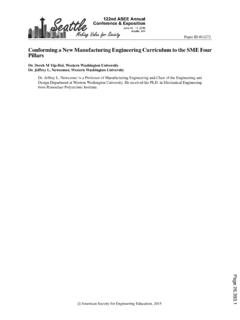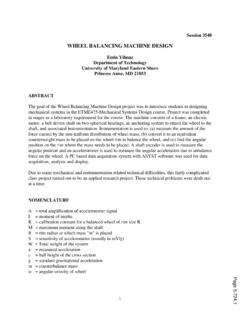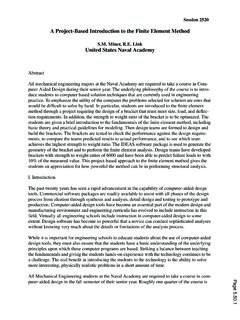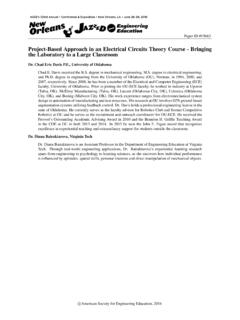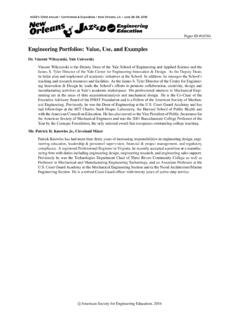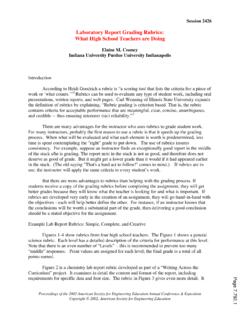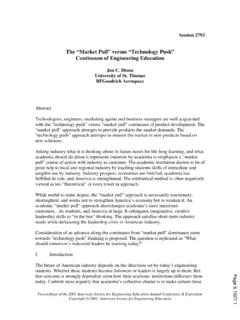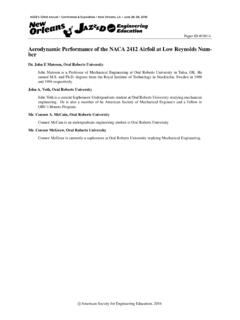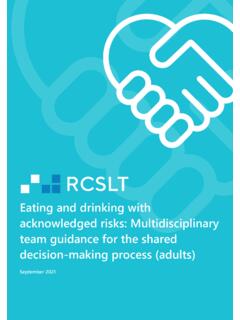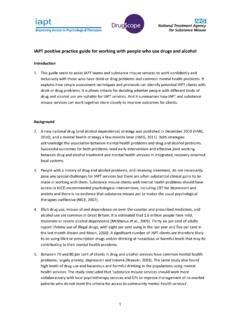Transcription of Engineering Competency Model
1 Paper ID #16232 Engineering Competency ModelMs. Catherine Leslie, Engineers Without Borders - USAMs. Leslie is a licensed Civil Engineer in Colorado with over 20 years of experience in the design andmanagement of civil Engineering projects. After ten years as Civil Engineering Manager at Tetra Tech,Inc., she assumed the role of Executive Director of Engineers Without Borders USA, a position she heldon a volunteer basis for six years. Ms. Leslie began her work in developing countries as a Peace CorpsVolunteer. Stationed in Nepal, she developed solutions related to drinking water and sanitation the last 30 years, whether working in corporate Engineering or nonprofit international develop-ment, Ms. Leslie has developed and utilized her technical interests in creating solutions for engineeringprojects that integrate the needs of the client along with the sustainable needs of the environment. AsExecutive Director of EWB-USA, Ms.
2 Leslie uses her organizational and project management skills toensure that the volunteer organization can fulfill its mission and vision. Ms. Leslie was a part of thesecond project to be completed within EWB-USA, a water project in Mail, Africa. There she workeddirectly with the community and other volunteers to develop a agricultural water source, and this projectwas what eventually led to her passion and interest in EWB-USA. After six years as the volunteer Exec-utive Director, Ms. Leslie joined EWB-USA as the second Executive Director since the organization sfounding in American Society for Engineering Education, 2016 The Engineering Competency Model ABSTRACT: An Engineering Competency Model has been developed to serve as a guide for the development of professionals in the Engineering workforce. The Engineering Competency Model ( the Model ) provides a career ladder/lattice for the Engineering profession and promotes an understanding of the skill sets and competencies that are essential to educate and train a globally competitive Engineering workforce.
3 This Competency Model for Engineering will serve as a resource to inform discussions among industry leaders, educators, economic developers, and public workforce investment professionals as they collaborate to identify specific employer skill needs, develop Competency -based curricula and training models, and develop industry-defined performance indicators, skill standards, and certifications. The creation of the Engineering Competency Model included an examination of existing bodies of knowledge, as well as the inclusion and involvement of the stakeholders within the Engineering community, including associations, industry and academia. As a part of this effort, work is also being done to provide materials for faculty, guidance counselors, and others who work with individuals who are entering the STEM pipeline to provide specific guidance on the core competencies and skills necessary, as well as those that an individual will need to maintain proficiency during their career.
4 The need for qualified engineers is expected to increase over the next seven years, with the Engineering field expected to grow by between 2012 and 2022. The result will be over 544,000 job openings due to growth and net replacements during that period. It is imperative that clear and specific guidance is given to those individuals who may be suited to fill this need and will enter into the STEM pipeline. This session will highlight the new materials which can be used by individuals, faculty, etc. to understand the core competencies and skills, as well as to provide a brief overview of the Engineering Competency Model creation. PAPER: A working partnership of several Engineering societies and a department of the federal government, the Team, has come together to develop and release the Engineering Competency Model ( the Model ). The Team identified the development of an Engineering Competency Model as a key priority to help educators, employers, professionals and future engineers understand the knowledge and skills needed to thrive in the workplace.
5 Funded by a generous grant from the United Engineering Foundation, the Team built the Model to provide a universal template for the knowledge, skills and abilities necessary not only for entering the Engineering profession but also for maintaining Competency and proficiency The Engineering Competency Model has the potential to unite the profession on the fundamental requirements that engineers will need to solve the global challenges we are facing. during one s career. The Engineering Competency Model is tied to lifelong learning and the individual tiers do not designate specific academic degrees. A Framework for the Engineering Profession: The Engineering Competency Model is designed to establish a more consistent guideline for the Engineering profession. The Model is intended for use by Industry leaders, employers and human resource professionals, to identify skill needs and assess competencies and performance Educators/academics, to inform the development of Competency -based curricula and training Workforce professionals and career counselors, to develop resources for career exploration and guidance Current and future engineers, to gain a clear understanding of the skills and abilities necessary to enter, advance and succeed in the industry The specific guidelines offered in the Engineering Competency Model were designed to assist in the understanding of the core set of abilities needed to enter the Engineering profession, in general, and to assist employees in maintaining their skills and be successful throughout their careers.
6 At its core, the Engineering Competency Model is a four-tier graphical Model that uses a pyramid to depict the required key competencies. Tiers one through four (the bottom four tiers) include personal, academic, workplace and technical competencies that are common to the Engineering profession. In the future, there will be an opportunity to adopt the Model and apply a fifth tier to include discipline-specific competencies. Tier six, the final optional tier, will be divided into two areas: competencies needed for management and occupation-specific requirements for a particular position within the Engineering profession. The graphic also lists the different competencies within each tier. (The full Engineering Competency Model is attached to better show the graphical tiers as well as an explanation of each Competency .) As an example, if a future engineer wished to understand what could be expected of their critical and analytical thinking skills in their future workplace, they could utilize Tier 2, Section of the Engineering Competency Model .
7 In this section, the future engineer would understand the expectations of the desired reasoning and mental agility skills needed and could identify future coursework to obtain those skills to ensure a smooth transition from an academic environment into the future work place. Likewise, educators can use the Model to identify gaps in a future engineers training and create a tailored education program to address those gaps. Engineering Competency Model Development Process: To begin development of the Model , the Team assigned a dedicated research working group to oversee the project, and recruited subject matter experts to review the vast amount of background information, including ABET accreditation criteria, bodies of knowledge from various Engineering societies, the Project Lead the Way outline, and curricula and related resources from academic institutions around the country. The working group also identified subject matter experts from amongst its own organizations, representing industry and academia, to assist the research team in developing and critiquing the draft Model through a series of webinars designed to gather feedback and further refine the draft.
8 Throughout the development of the Engineering Competency Model , the working group sought to gather feedback and input from stakeholders across the Engineering community, from educators of future engineers to those who employ engineers. A webinar was held in February, 2015 for Engineering societies and other stakeholders to explain the development process, discuss how the Model could be a useful tool for Engineering -related societies in the future, and get feedback on the preliminary draft. The working group also distributed a survey to solicit feedback from the Engineering community and gathered input from over 100 Engineering leaders, which was used to inform updates and revisions to the Model . In April, 2015, the working group held a Validator s Meeting with the subject matter experts, representatives from Engineering societies, and other members of the Engineering community to gather additional insight and finalize the Engineering Competency Model .
9 Additionally, the Model is currently being endorsed by those Engineering societies. The Engineering Competency Model is attached. Moving Forward: With the need for qualified engineers expected to increase over the next seven years, the Engineering field is expected to grow by between 2012 and 2022. The result will be over 544,000 job openings due to growth and net replacements during that period. It is imperative that clear and specific guidance is given to those individuals who may be suited to fill this need and will enter into the STEM pipeline. Promotion and continued work on the Engineering Competency Model is a crucial activity, as it has the potential to provide future practitioners with the knowledge of the competencies that will be necessary for this global engineer of the future. This session will highlight the new materials which can be used by individuals, faculty, etc. to understand the core competencies and skills, as well as to provide a brief overview of the Engineering Competency Model creation.
10 Employment and Training Administration United States Department of Labor Engineering Competency Model May 2015 1 Engineering Competency Model May 2015 Employment and Training Administration United States Department of Labor Engineering Competency Model May 2015 2 Table of Contents About the Model .. 4 Tier 1 Personal Effectiveness Competencies .. 6 Interpersonal Skills .. 6 Integrity .. 6 Professionalism: .. 7 Initiative .. 7 Adaptability and Flexibility .. 8 Dependability and Reliability .. 8 Lifelong Learning .. 9 Tier 2 Academic Competencies .. 11 Reading .. 11 Writing .. 11 Science and Technology .. 13 Communication .. 13 Critical and Analytical Thinking .. 14 Computer Skills .. 15 Tier 3 Workplace Competencies .. 16 Teamwork .. 16 Client/Stakeholder Focus .. 16 Planning and Organizing .. 17 Creative Thinking .. 18 Problem Solving, Prevention and Decision Making.


